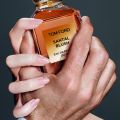
rowan.walters 06/20/14 08:23
I grew up with an inexplicable, passionate fondness for White/Mysore sandalwood, and as an adult this fragrance would always elicit a powerful sense of profound pleasure and relaxation. More than that, it triggered an internal scent memory forever linked with comfort, safety and serenity.
I recently discovered the source of these childhood associations: as a toddler I was fascinated with a wooden fan made from hand-carved Mysore sandalwood - one of several that my parents had brought back from India in the 1960s, and apparently I used to take this fan with me everywhere. Curiously, I can still see it in my mind's eye - intricately carved strips of wafer thin sandalwood joined together by a red silk band and exuding a wonderfully regal, majestic aroma that will forever live in my memory.
Almost ten years ago now, it suddenly became difficult to find real Myssore sandalwood from India and many of my favourite products - including Crabtree & Evelyn Extract of Mysore Sandalwood either became unavailable or changed their formulation.
Although white sandalwood is difficult to obtain from India these days, there are many other places which produce Santalum Album, such as Indonesia, Malaysia and China - and because these areas still have enormous reserves of old-growth forests the quality is infinitely superior to the Indian equivalent.
But by the same token sustainable and renewable plantations of Santalum Album, Santalum Spicata, and other fragrant woods like the endangered members of the Aquillaria genus, have been planted on a massive scale in Australia.
Currently there are more Mysore Sandalwood trees in Australia than India, and in coming decades they will hopefully fill the gaping void in the market.
So there is definitely hope for the future of sandalwood.
And until then we have some wonderful new molecules to play with.
In recent months I have started experimenting with Sandalore, Sandela, Indisan, Javanol, Osyrol, Ebanol and countless others and it has been both fascinating and exciting to see how effectively science has been able to replicate different facets of one of the most sophisticated products of nature, which has been venerated by every culture it came into contact with since ancient times.
And just a quick comment about the relative safety of these particular fragrance molecules - while they may be synthetic, the vast majority of the sandalwood and woody type aroma chemicals are derived from plant sources that have been known to science for over a century, so in terms of their chemical structure they are, for the most part, a "variation on a theme" and less liable to cause hormone disruption or carcinogenesis than many other synthetics.
And even 100% natural essential oils have health risks.
Young children especially should NEVER be exposed to Lavender and Tea Tree Oil on a regular basis, especially young boys.
Those oils contain incredibly potent phyto oestrogens that have caused young boys to grow breasts and girls as young as five to enter premature puberty.
So long as fragrances - natural and synthetic - are diluted and used sensibly, they will continue to add an extra dimension of beauty to our lives, enhancing our overall quality of life as well as bringing pleasure.
And for me sandalwood is a sacred scent memory that brings peace, comfort and serenity, and I hope to enjoy its beauty as long as I live.












 Write your comment:
Synthetic Pathways to Sandalwood Notes
Write your comment:
Synthetic Pathways to Sandalwood Notes




































